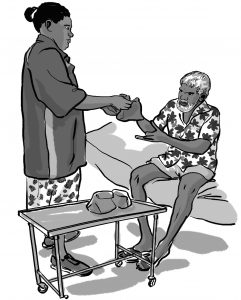Some people find the idea of writing a care plan (particularly a Consumer Directed Care plan) daunting however it needn't be. Let me see if I can break down the process so it’s a little easier to understand.

Firstly, the essence of any care planning is identifying what support services are to be provided to the client* and who will provide them. If you have assessed the client you will know what things they can manage independently and what things they need help with. If you have assessed the client for support through a Home Care Package you'll also have gathered information on the reasons for accessing care and their goals and also know how much input they want to have into the coordination of their support.
Aspects of a Care Plan
The care plan will include:
- The purpose for providing assistance to the client;
- Identifying the services to be provided to the client;
- Describing the goals or outcome sought for each individual service;
- Identifying who will provide the service;
- Stating when the service will be provided, and for how long where relevant; and
- Identifying the case management, review and reassessment arrangement.
Let’s look at these in more detail:
1. Purpose Statement
Every client will have an overall reason for being on the program; this may be a long or short term purpose. Generally you would have identified this during the assessment process. It may be something like:
- Wanting to stay living independently at home
- Seeking to regain their strength and health after an operation
- A desire to finish up (pass away) on their land
2. Strategies to meet the client's needs
Once you know what the client wants to gain from care provision and support, you and the client can look at ways to meet those needs. Some supports may be provided by the aged care service, some by the client's family and others by another service provider. Where possible the client should be actively involved in the decision making process.
3. Services to be provided
You only need to document services that the client or their family have identified as areas where they need help. For example if the assessment process identified that the client needed help with laundry, meal preparation, medication management and personal care, those are the areas that need to be written into the care plan. Note these down even if your service won’t provide all the help; we’ll look at why in a minute.
4. Goals
For every service offered to the client, whether this is to be done by the aged care service, the clinic, the client’s family or another provider, there should be a goal attached. Think about it this way:
- What does the client or their family carer hope to gain from receiving the service?
- Why are you providing the service?
Here is an example:

Meal delivery
Delivered Meals
Is this being provided:
- To support the family / carer in their caring role
- To provide the client with nutritional variety and assist to access foods suitable to meet their diabetic / specialised dietary requirements
- To minimise the risk of dehydration in hot weather
- To assist the client gain / maintain weight
5. Identifying responsibility
In a community aged care setting you won’t be providing all care and support to a client, there may be family or friends, other agencies or even private services also supporting the client.
Make sure you identify who is responsible for the service or sections of the service.
Caution: If you fail to note down who is responsible for providing the help for an area that you have identified as needed by the client you may find the responsibility rests with your organisation if something goes wrong.
6. Time and duration of service
Time of service is often a difficult area to pin down on remote communities as many clients prefer their needs addressed on an ‘as required’ basis, particularly for assistance with transport or shopping and many services try to remain responsive to consumer demand. However it is possible to develop rosters of laundry, be responsive to individualised personal care, identify days for activities, shopping and approximate times for meal deliveries and any other regular support services.
7. Reassessment
Remember a care plan is a ‘living document’. This means that if the client’s needs change, you need to reassess the client’s needs and alter their care plan where required. At a minimum, though, you would reassess the client and update their care plan annually.
* I have used the term client throughout this post due to it's current widespread use however the new terminology is ‘consumer.'
- Aged Care Packages – what's in the box? - February 16, 2024
- 11 Ways to Make Your Progress Notes Better - September 22, 2023
- Vulnerable Clients – Who are they? - July 14, 2023



